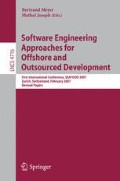Abstract
Given that software offshore outsourcing is a business relationship, we assume that a contract is required in order to define what services are requested from a contracted entity and how these services are to be delivered to the satisfaction of the contractor. We first argue that, at the heart of the quality assurance facets of such a contract, we must find a single testable model of both the functional and non-functional requirements of the system to be delivered. We present the key properties that such a model must exhibit: testability, executability, scenarios as grammars of responsibilities, and support for abstraction. We then observe that, typically, existing approaches to requirements engineering do not offer such characteristics. We conclude by briefly discussing a prototype conformance testing environment that supports these properties.
Access this chapter
Tax calculation will be finalised at checkout
Purchases are for personal use only
Preview
Unable to display preview. Download preview PDF.
References
Meyer, B.: The unspoken revolution in software engineering. IEEE Computer (January 2006)
Binder, R.: Testing, Object-Oriented Systems. Addison-Wesley, London, UK (2000)
Gold, T.: Outsourcing Development Offshore: Making it Work. Auerbach Publications (2004)
Kotonya, G., Sommerville, I.: Requirements Engineering. John Wiley & Sons, West Sussex, England (1998)
Davies, A.: Software Requirements: Objects, Functions and States. Prentice-Hall, Englewood Cliffs (1993)
Czarnecki, K., Stahl, T., Voelter, M.: Model-Driven Software Development: Technology, Engineering, Management. John Wiley & Sons, West Sussex, England (2006)
Corriveau, J.P., Bashardoust-Tajali, S.: Generative hierarchical contracts for conformance testing of sequential containers. In: Proceedings of IASTED’s Conference on Software Engineering (2007)
Meyer, B.: Reusable Software: The Base Object-Oriented Component Libraries. Prentice-Hall, Englewood Cliffs (1994)
Meyer, B.: Object-Oriented Software Construction. Prentice-Hall, Englewood Cliffs (1994)
Ryser, J., Glinz, M.: Using dependency charts to improve scenario-based testing - management of inter-scenario relationships. In: Watanabe, O., Hagiya, M., Ito, T., van Leeuwen, J., Mosses, P.D. (eds.) TCS 2000. LNCS, vol. 1872, Springer, Heidelberg (2000)
Jacobson, I.: Object-Oriented Software Engineering. Addison-Wesley, London, UK (1992)
Boehm, B.: A spiral model of software development and enhancement (1988)
Gomaa, H.: Designing Concurrent, Distributed and Real-Time Applications with UML. In: Evans, A., Kent, S., Selic, B. (eds.) UML 2000. LNCS, vol. 1939, Springer, Heidelberg (2000)
Briand, L., Labiche, Y., Sun, H.: Investigating the use of Analysis Contracts to Improve the Testability of Object-Oriented Code, vol. 33(7), pp. 637–672. John Wiley & Sons, Inc, West Sussex, England (2003)
Czarnecki, K., Eiseinecker, U.: Generative Programming: Methods, Tools and Applications. Addison-Wesley, London, UK (2000)
Ambler, S.: Agile Modeling. John Wiley & Sons, West Sussex, England (2002)
Beck, K.: Test-Driven Development By Example. Addison-Wesley, London (2002)
Rumbaugh, J., Jacobson, I., Booch, G.: The Unified Modeling Language Reference Manual. Addison-Wesley, Reading (1998)
Miles, R., Hamilton, K.: Learning UML 2.0. O’Reilly (2006)
Briand, L., Labiche, Y.: A uml-based approach to system testing. In: Gogolla, M., Kobryn, C. (eds.) «UML» 2001 – The Unified Modeling Language. Modeling Languages, Concepts, and Tools. LNCS, vol. 2185, Springer, Heidelberg (2001)
Kazman, R., Klein, M., Clements, P.: Atam: Method for architecture evaluating the quality attributes of a software architecture. Technical Report CMU/SEI-200-TR004, Software Engineering Institute, Carnegie Mellon University (2000)
Arnold, D.: Supporting Generative Contracts in.NET. PhD thesis (2007)
Author information
Authors and Affiliations
Editor information
Rights and permissions
Copyright information
© 2007 Springer-Verlag Berlin Heidelberg
About this paper
Cite this paper
Corriveau, JP. (2007). Testable Requirements for Offshore Outsourcing. In: Meyer, B., Joseph, M. (eds) Software Engineering Approaches for Offshore and Outsourced Development. SEAFOOD 2007. Lecture Notes in Computer Science, vol 4716. Springer, Berlin, Heidelberg. https://doi.org/10.1007/978-3-540-75542-5_3
Download citation
DOI: https://doi.org/10.1007/978-3-540-75542-5_3
Publisher Name: Springer, Berlin, Heidelberg
Print ISBN: 978-3-540-75541-8
Online ISBN: 978-3-540-75542-5
eBook Packages: Computer ScienceComputer Science (R0)

